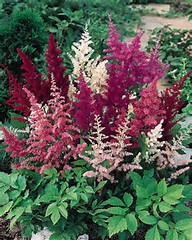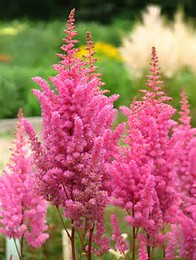 Even shaded areas can be colorful
Even shaded areas can be colorful
If you are looking to incorporate color, beauty and low maintenance into areas of your yard that may be shaded, I hope you consider Astilbe, a perennial from the Saxifragaceae family that flourishes in shady areas and/or containers. Typically described as “a beautiful, showy flower atop glossy, fern-like foliage,” they can add color and texture to places where full-sun flowers fail to thrive.
Astilbes are native to mountain ravines and woodlands, blooming mid-spring to late summer in zones 4-8. (For zoning questions Jeff Lowenfels has a great article in the ADN from February 26, 2016 titled “Jeff Lowenfels: In Alaska, USDA hardiness zones are complicated”). Their botanical name is Astilbe, with common names of False Spirea, false Goat’s Beard, and Meadowsweet.
While Astilbes grow well in shade, exposure to morning sun or partial sun of no more than 1-2 hours per day will help promote flowering. Soil should be rich, organic type soil, not dry or heavy clay. Flowers grow in clusters that vary in sizes ranging from 6 inches to 2 feet with a height of 6 inches to 5 feet. The stems are stiff and do not require staking. There are 25 different species with hundreds of hybrids. Credit for the majority of these hybrids is given to Georg Arends, known as a “master hybridizer” while working in Ronsdorf, Germany. Incorporating a variety of hybrids with various heights and colors in groupings creates dramatic, eye-catching displays.
Planting bare-root plants is recommended over seeds. Planting seeds often results in short-lived plants which are difficult to germinate. When planting rooted plants, the holes should be twice as wide as the plant and 4-6 inches deep. The roots should be planted in a slightly fanned position, pointing downward with the crown planted 1-2 inches below the soil. Caution: the crowns often rise out of the soil as they grow. The crown needs to remain covered, so in that event, apply additional soil or otherwise replant.
Growing Astilbe in containers can be easy and allows for repositioning if sun exposure become too much. Ensure your container is large enough to allow for growth, with recommendations of the container width at least 16 inches with a depth of 12 inches. Use larger containers if planting multiple plants. Potted plants benefit from water-soluble fertilizers applied twice monthly spring through fall. Care for Astilbes is fairly easy. Here are 4 easy checks if your Astilbes are not blooming.
1. Soil and moisture – Do not allow soil to become too dry. General rule is one deep watering weekly. Add bark chips or other moisture-retaining mulch if necessary to prevent drying. Make sure you’re the soil has good drainage, eliminating any standing water. This can damage your plants.
2. Sunlight – Avoid full sunlight. Astilbe prefers moderate light, but best in shade. Consider moving your plants if you notice overexposure. Overexposure or prolonged direct sunlight can “burn the plant”.
3. Fertilizer – Under-nourished plants can reduce bloom production. Recommendations are a 3-2-2 ratio of slow-release fertilizer in spring and high-nitrogen fertilizer when plants are “setting buds” late summer or early fall. (Fertilizers are always labeled in a specific sequence as seen above. This refers to the percentages of Nitrogen, Phosphorus and Potassium.) Consider amending the soil regularly with compost or well-rotted manure. When testing pH of the soil, Astilbe prefers a 6.0. (The pH of soil measures the acidity and alkalinity levels of soil. The levels range from 0-14, with 7 being neutral. Results less than 7 is a more acidic soil and higher than 7 more alkaline soil. Most plants prefer 5.5-7, with many able to adapt to levels outside of this.)
4. Maintenance – Division of plants should occur when plants are no less than 3 years of age. Removing spent blooms is recommended for aesthetic purposes but not required. Deadheading will not promote blooming.
Some of the more popular varieties include “Fanal”, a dark green foliage with dark crimson flowers; “Irrlicht”, a dark green foliage with white flowers; “Venus”, a bright green foliage with bright pink flowers. When partnering Astilbes with other plants that consider Hostas and/or Heuchera (hardiness zone 3), and Ligularia and/or (zones 4-7).
Earlier this summer I planted Astilbe in my flowerbed on the south side of the yard but the plants struggled through most of the summer, even with daily watering. These were from a friend’s garden who has had them for the past 4 years and needed to divide the plants. The plants struggled through the summer. By the end of summer and after researching what I was doing wrong, I built flowerbeds on the north side of the yard using dirt from my compost incorporated with our native soil already packed with clay. With an early morning sun exposure and partial late afternoon, the plants began to thrive. With it being late in the season we were not able to experience a full growing season but look forward to this next summer.
“Why America loves Astilbes”, American Meadows.com
“Container Grown Astilbe”, Gardening, Know How.com
“Jeff Lowenfels: In Alaska, USDA hardiness zones are complicated”, ADN.com, February 26, 2016
Old Farmers Amanac.com
There’s a Moose in My Garden Designing Gardens in Alaska and the Far North. Adams, Brenda. University of Alaska Press, Fairbanks, Alaska: 2013.
